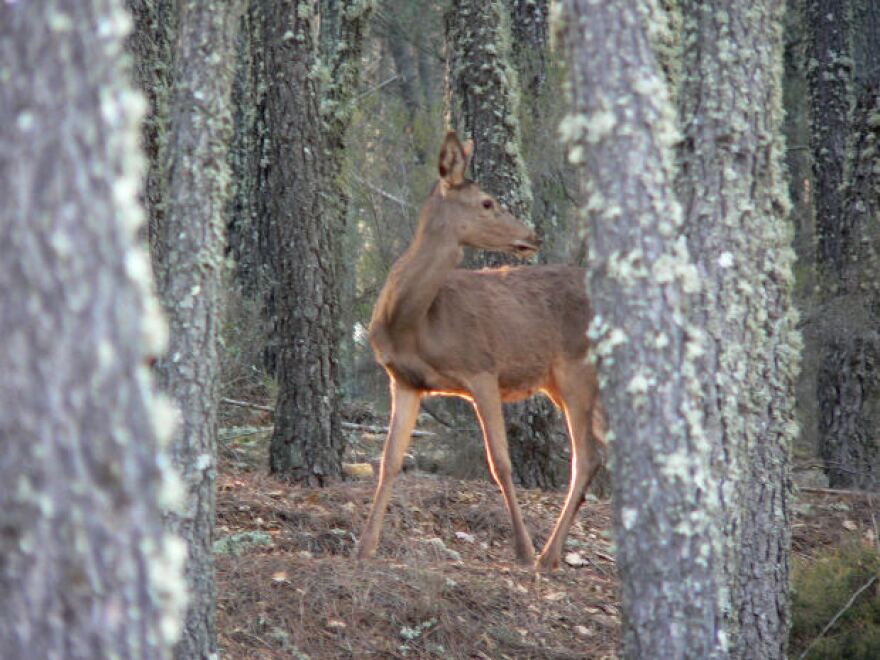White-tailed deer cause an estimated 50,000 car crashes in Virginia each year, do millions of dollars in damage to farm crops, trees and gardens.
Under ideal conditions, the deer population can double every year. The state counts on hunters to help keep the number of deer in check, and officials are now looking at other ways to promote healthy living with deer.
Deer are amazing animals, with many natural gifts that allow them to survive and multiply. Al Cambronne has written a book called Deerland, which details their super powers. “They can hit up to 36 miles per hour, leap an 8-foot fence. In their noses they’ve got about 300 million scent receptors. For comparison, bloodhounds have about 220 million. They’ve got big, giant cupped ears that are swiveling constantly to pick up sounds -- like big radar antennas.”
And they can survive cold weather without help from humans, according to Nelson Lefon at the Virginia Department of Game and Inland Fisheries. “You know a lot of people are concerned, especially in the winter that deer are going to starve. They’re not getting enough food, but that’s part of nature and part of what they’ve evolved into. Deer reduce their metabolic level in the winter. They’re used to not having a lot of food.”
When their numbers get too big, they do starve, and Lafon says deer will eat plants needed by other animals. So the state tries to control deer populations – to balance their needs with those of people and other wildlife. At least 50 cities, towns and suburbs have approved hunting or culling, and the state has raised bag limits to six per year East of the Blue Ridge, five per season to the west, and in four Northern Virginia counties the state permits hunters to shoot as many deer as they like.
Author and deer expert Jack Landers says that’s good – but higher bag limits are offset by a declining number of hunters. “What we need is for adult beginners, people from the local food movement, people who want to take part in their ecosystem to step up to the plate and say, ‘I’m going to learn to hunt,’ and we need land owners to make land available to hunters. If you’ve got a parcel of 10, 20, 30 acres, and nobody’s hunting it, you’ve got no trespassing signs up, find a hunter that you trust – get to know them and give them access.”
Some wildlife lovers have argued for the use of contraceptives to restrict the deer population, but author Al Cambronne says that won’t work. “We don’t really have any handy oral deer birth control that we can sprinkle around in the woods or put out on a pile of corn. Deer birth control is great in theory, but in practice it doesn’t work so well. It’s difficult, expensive and temporary, and that’s for the deer we do manage to inject. All the rest are still fertile.”
The state has had some success with reducing deer-car collisions – building highway underpasses that allow the animals to cross safely. And Jack Landers says fencing can minimize carnage on the highways. He’s seen the evidence in Florida. “They’ve got a lot of their highways fenced, mostly to keep alligators off the road, and in those stretches of road I see very little road kill. It seems to work very well.”
But that, too, is expensive. The Department of Game and Inland Fisheries is now working on a new plan to control the deer population in Virginia. In some parts of the state, Nelson LaFon says current policy requires hunters to shoot at least one doe before they can claim a second buck with the treasured trophy antlers. “People can shoot all the bucks they want. It makes no difference in population control. It’s all about the does when it comes to controlling population.”
The state has also banned feeding of deer through the first Saturday of January, and it’s illegal year round in seven counties and in the city of Winchester. Experts say luring deer to feed at a central point can spread disease, increase crashes in neighborhoods, and lead to people getting hurt.
A 17-member advisory committee is now working with the Department of Game and Inland Fisheries and researchers at Virginia Tech to craft a plan for deer management through 2015.



